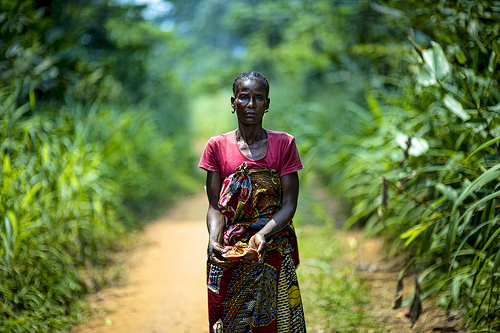
- CoFCCA
- The project
- Outcomes
Outcomes
Following the outcome mapping approach, three types of boundary partners were included in the project:
- forest communities (forest-dependent communities, indigenous people, logging companies, non-government organizations, women’s groups, traditional authorities, etc.)
- national government officials and policy makers (ministries of environment, forestry, etc.)
- regional organizations (e.g. COMIFAC, Central African Regional Program for the Environment).
Based on the four strategic objectives of CoFCCA, the following outcomes were achieved for boundary partners.
Strategic objective 1. Identification and prioritization of forest-based sectors through a regional science–policy dialogue process to assess climate risks and the vulnerability of livelihoods linked to these prioritized sectors, and to plan adaptation strategies for climate change and climate variability.
- Regional inception workshop held with over 60 stakeholders from different levels attending.
- Consultations with stakeholders continually held at various levels and stages through the participatory approach of the project.
- A thorough review of literature and policy documents undertaken in all countries as the basis for a situation analysis.
- Situation analysis and baseline characterization conducted (with stakeholders and through network analyses etc.).
- Field visits to forest communities conducted in preparation for the participatory action research to analyze perceptions of of climate change and coping and adaptation strategies.

Charcoal production in the forest near the Village of Ovangoul, Central Region, Cameroon. Photo by Ollivier Girard/CIFOR
Strategic objective 2. Identification of adaptation strategies that focus on the relationships between climate change, forest ecosystems and community well-being and livelihoods.
- Literature review of forest ecosystem services provision and livelihoods undertaken.
- Consultations with key stakeholders conducted to delineate pathways for mainstreaming adaptation.
- Participatory sectoral analysis elaborated.
- Consultations on climate risks perceptions carried out with national level stakeholders.
- Surveys distributed to identify and disaggregate indigenous and innovative coping strategies.
- Critical livelihood strategies identified.
Strategic objective 3. The assessment of vulnerability of gender and minority groups, including indigenous communities, to highlight their special needs for climate change adaptation and to explore ways of engaging their participation in national adaptation planning processes and policy formulation.
- The situation of women and indigenous groups analyzed through the Sustainable Livelihoods Framework and innovative systems approaches.
- Analyses of gender vulnerability conducted:
- socio-economic analyses of climate impacts on women-led activities
- analyses of aspects related to rights and resources, access, governance, tenure, equity and well-being for women and indigenous groups and their implications for adaptive capacity.

Woman farmer with local fruit on the way to Tumba – Ledima Reserve, Democratic Republic of Congo.Photo by Ollivier Girard/CIFOR
Strategic objective 4. Capacity development of local communities and other stakeholders through training and direct participation in the implementation of all phases of the project through a continuous ‘learning by doing’ process.
- Team members and key actors trained in participatory monitoring and evaluation.
- Participatory monitoring and evaluation continued throughout the project.
- Strategies and platforms developed for sharing lessons learned.
- Graduate students’ annual fellowship program developed to build the scientific capacity of the region’s future scientists.
- Short trainings, workshops and field days held throughout the project.
Adaptation pilot activities are being implemented in six villages. Initiatives that have remained operational after the conclusion of the project include crop and non-timber forest product activities.


